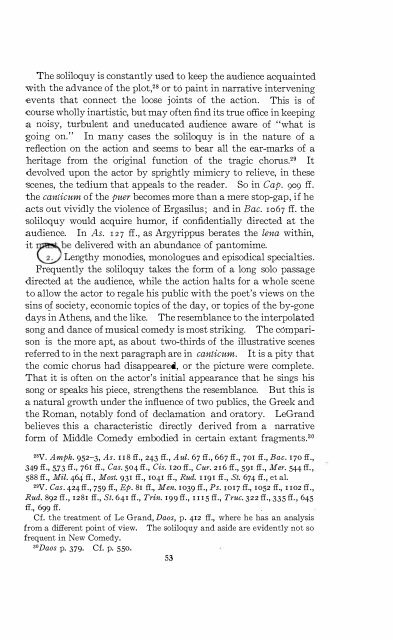You also want an ePaper? Increase the reach of your titles
YUMPU automatically turns print PDFs into web optimized ePapers that Google loves.
The soliloquy is constantly used to keep the audience acquainted<br />
with the advance of the plot,28 or to paint in narrative intervening<br />
events that connect the loose joints of the action. This is of<br />
course wholly inartistic, but may often find its true office in keeping<br />
a noisy, turbulent and uneducated audience aware of "what is<br />
going on." In many cases the soliloquy is in the nature of a<br />
reflection on the action and seems to bear all the ear-marks of a<br />
heritage from the original function of the tragic chorus.29 It<br />
devolved upon the actor by sprightly mimicry to relieve, in these<br />
'Scenes, the tedium that appeals to the reader. So in Cap. 909 ff.<br />
the canticum of the puer becomes more than a mere stop-gap, if he<br />
acts out vividly the violence of Ergasilus ; and in Bac. 1067 ff. the<br />
soliloquy would acquire humor, if confidentially directed at the<br />
audience. In As. 127 ff., as Argyrippus berates the lena within,<br />
it be delivered with an abundance of pantomime.<br />
\...:.;.) Lengthy monodies, monologues and episodical specialties.<br />
Frequently the soliloquy takes the form of a long solo passage<br />
directed at the audience, while the action halts for a whole scene<br />
to allow the actor to regale his public with the poet's views on the<br />
sins oJ society, economic topics of the day, or topics of the by-gone<br />
days in Athens, and the like. The resemblance to the interpolated<br />
song and dance of musical comedy is most striking. The compari<br />
son is the more apt, as about two-thirds of the illustrative scenes<br />
referred to in the next paragraph are in canticum. It is a pity that<br />
the comic chorus had disappeared, or the picture were complete.<br />
That it is often on the actor's initial appearance that he sings his<br />
song or speaks his piece, strengthens the resemblance. But this is<br />
a natural growth under the influence of two publics, the Greek and<br />
the Roman, notably fond of declamation and oratory. LeGrand<br />
believes this a characteristic directly derived from a narrative<br />
form of Middle Comedy embodied in certain extant fragments.3o<br />
28V. Amph. 952-3, As. lI8 ff., 243 ff., Aul. 67 ff., 667 ff., 701 ff., Bac. 170 ff.,<br />
349 ff., 573 ff., 761 ff., Cas. 504 ff., Cis. 120 ff., Cur. 216 ff., 591 ff., Mer. 544 ff.,<br />
588 ff., Mil. 464 ff., Most. 931 ff., 1041 ff., Rud. Il91 ff., St. 674 ff., et al.<br />
29V. Cas. 424 ff., 759 ff., Ep. 81 ff., Men. 1039 ff., Ps. 1017 ff., 1052 ff., II02 ff.,<br />
Rud. 892 ff., 1281 ff., St. 641 ff., Trin. 199 ff., Il15 ff., True. 322 ff., 335 ff., 645<br />
iI., 699 ff.<br />
Cf. the treatment of Le Grand, l)aos, p. 412 ff., where he has an analysis<br />
from a different point of view. The soliloquy and aside are evidently not so<br />
frequent in New Comedy.<br />
30Daos p. 379. Cf. p. 550.<br />
53
















